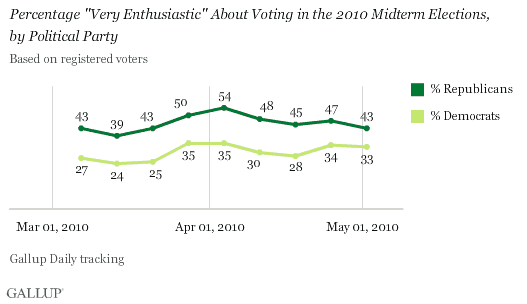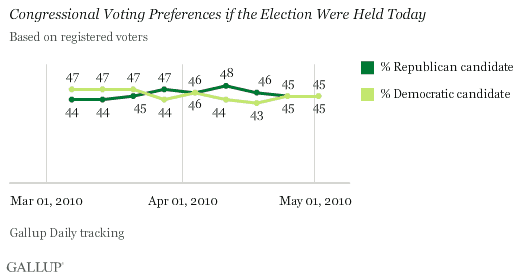PRINCETON, NJ -- Republican registered voters' enthusiasm about voting in this year's midterm elections has declined significantly in recent weeks. As a result, Republicans' advantage over Democrats on this measure has shrunk from 19 points in early April to 10 points in the latest weekly aggregate.

In late March and early April, after Congress' passage of healthcare reform, both Republican and Democratic registered voters became more enthusiastic about voting in this year's elections. Republicans' enthusiasm peaked at 54% "very enthusiastic" in late March and early April, but is 43% in the latest weekly update, from April 27-May 2 -- essentially where it was before healthcare passed. By contrast, Democrats have more or less retained the slightly higher level of enthusiasm they showed right after the healthcare bill milestone.
Republicans' current 10-point lead is the smallest Gallup has measured since it began tracking 2010 election attitudes in March.
Among all registered voters, the percentage who are very enthusiastic about voting is also down, from 40% in late March to 35% in the latest figures. (See the tables on page 2 for the full trend on enthusiasm.)
Split Electorate Makes Turnout Key
For the second consecutive week, registered voters remain evenly divided in their current vote preferences between the Republican and Democratic candidates in their congressional districts on Gallup's "generic ballot." Republicans had enjoyed a slight edge for most of the period after the passage of healthcare reform in late March until mid- to late April, but had trailed prior to that.

If registered voter preferences remain evenly divided, turnout will ultimately decide which party has a better night on Election Day. Historically, Republicans turn out at higher rates than Democrats, which means a tie among registered voters is generally more indicative of a stronger Republican than Democratic showing on Election Day.
As long as Republicans maintain an advantage in voting enthusiasm, it would appear unlikely that Democrats would be poised to upset this typical pattern on Election Day. As the campaign continues, two indications in Gallup's data of a possibly strong Democratic showing would be a continued closing of the enthusiasm gap versus Republicans, and the Democrats' moving ahead of Republicans in registered-voter preferences on the generic ballot.
Results are based on telephone interviews with 1,581 national adults, aged 18 and older, conducted April 26-May 2, 2010, as part of Gallup Daily tracking. For results based on the total sample of national adults, one can say with 95% confidence that the maximum margin of sampling error is ±4 percentage points.
Interviews are conducted with respondents on landline telephones (for respondents with a landline telephone) and cellular phones (for respondents who are cell phone only).
In addition to sampling error, question wording and practical difficulties in conducting surveys can introduce error or bias into the findings of public opinion polls.


